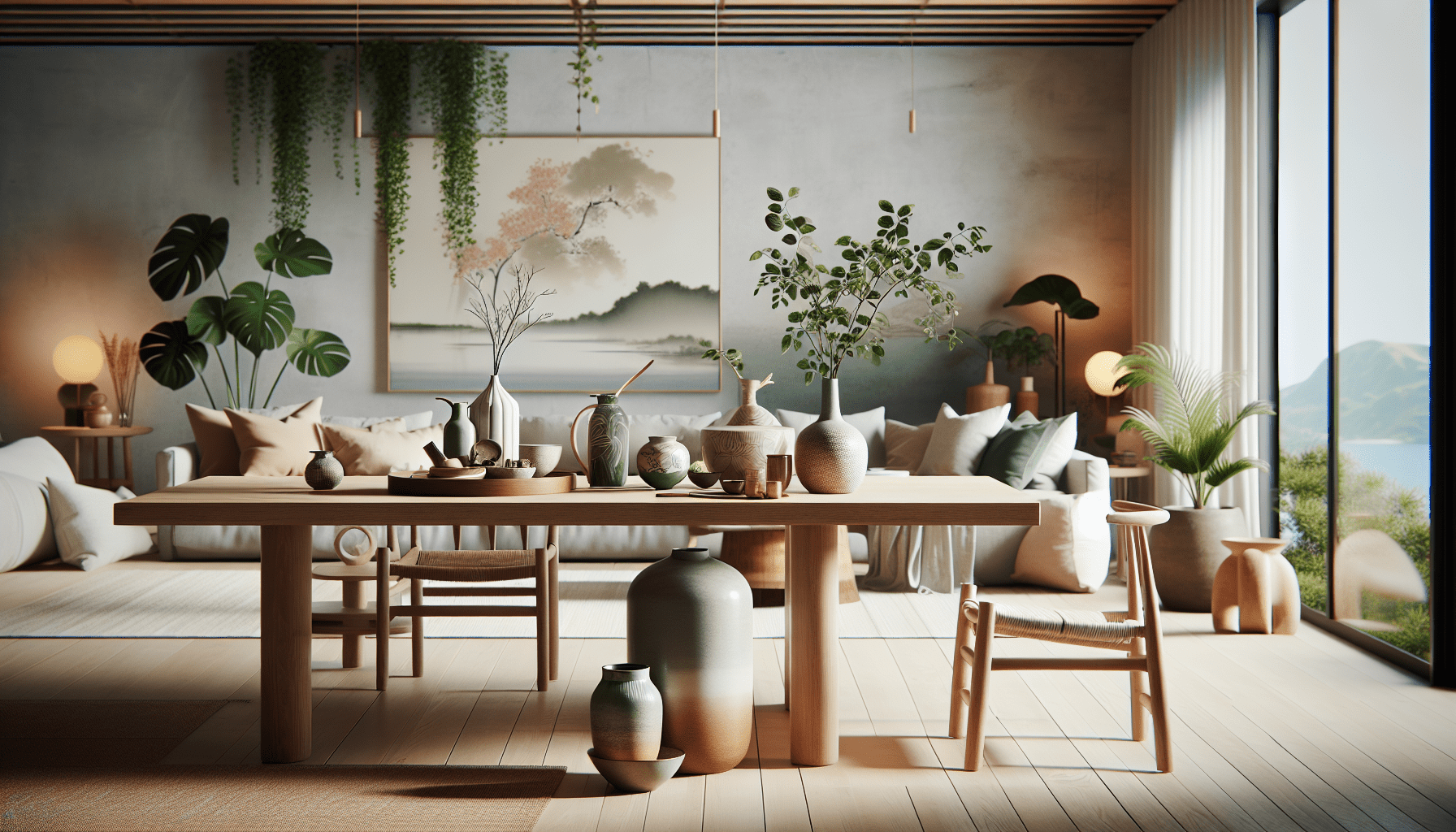What if you could transform your open-concept space into a serene and stylish environment?
Understanding Japandi Design
Japandi is a design philosophy that harmonizes Japanese minimalism with Scandinavian functionality, creating spaces that feel tranquil and inviting. This aesthetic emphasizes simplicity, natural materials, and a blend of both cultures which can produce a cozy yet sophisticated ambiance.
Key Characteristics of Japandi Style
To understand how Japandi can fit into an open-concept space, it’s beneficial to unpack its key features:
-
Neutral Color Palette: Japandi leans heavily on muted tones such as whites, grays, and earthy hues. This creates a calm environment, perfect for larger spaces where you want to cohesively tie different areas together.
-
Natural Materials: A strong preference for wood, bamboo, and ceramic materials plays a significant role. Incorporating natural textures helps ground the space and promotes a sense of warmth.
-
Functional Furniture: Each piece of furniture serves a purpose, reflecting a minimalist approach. This can be especially useful in open-concept layouts, where each item should contribute to the functionality of the entire area.
-
Clutter-Free Zones: The principle of “less is more” is central to Japandi. Open spaces benefit greatly from this philosophy, as reducing clutter keeps the area feeling airy and spacious.
Open-Concept Spaces: A Design Challenge?
Open-concept layouts prioritize fluidity and interconnectedness, but they can pose challenges when it comes to design. With areas flowing seamlessly into one another, achieving a cohesive yet functional space can often feel overwhelming.
The Benefits of Open-Concept Living
Before exploring how Japandi might fit into this design style, it’s worth acknowledging the advantages of an open-concept space:
-
Increased Natural Light: The absence of walls allows for better light flow throughout the space, making it feel brighter and more inviting.
-
Enhanced Social Interaction: Open layouts foster communication and interaction, perfect for families and entertaining guests.
-
Versatility: With fewer barriers, you have the flexibility to arrange furniture in various configurations, adapting the space to your needs.
Challenges with Open-Concept Spaces
While they undoubtedly have their perks, open-concept designs can also lead to specific issues:
-
Lack of Privacy: It can be difficult to find quiet spaces for work or relaxation when all areas are visually connected.
-
Difficult to Define Areas: Distinguishing between living, dining, and workspace can be challenging without walls or barriers.
-
Potential for Clutter: With everything visible, it’s easy for open spaces to feel disorganized or cluttered over time.
Making Japandi Work in Your Open-Concept Layout
Now, let’s talk about how you can merge the tranquility of Japandi with the flow of an open-concept space. By taking the key elements of Japandi design and applying them strategically, you can achieve a harmonious blend.
Define Functional Zones
Start by defining specific areas within your open-concept design. While walls can inhibit flow, you can use furniture arrangement to create visual boundaries.
| Zone | Suggested Furniture | Japandi Touch |
|---|---|---|
| Living Area | Sofa, coffee table, bookshelves | Low-profile furniture for minimalism |
| Dining Area | Dining table, chairs, storage solutions | Natural wood pieces to enhance warmth |
| Work Space | Desk, task chairs, organizers | Sleek, functional designs for efficiency |
By arranging your furniture thoughtfully, you create designated areas that invite different activities while still remaining cohesive.
Choosing the Right Color Palette
When aiming for a Japandi look, selecting the right colors can unify your space beautifully. Neutral tones work best, blending Scandinavian cool with Japanese earthy warmth.
Here are some popular color pairings to consider:
| Color | Japanese Influence | Scandinavian Influence |
|---|---|---|
| Soft Beige | Warmth and Comfort | Calm and Relaxed |
| Cool Gray | Minimalist Aesthetic | Modern Elegance |
| Sage Green | Nature and Tranquility | Connection to Environment |
Incorporate Natural Materials
Bringing natural elements into your open-concept space will enhance the Japandi aesthetic. Think about introducing wooden furniture and organic textiles like cotton or wool that contribute to softness.
- Wood: Use light-toned wood for furniture and accents. This aligns perfectly with both Japanese and Scandinavian traditions.
- Plant Life: Adding greenery introduces life and a connection to nature, essential to the Japandi ethos. Consider low-maintenance plants like succulents or ferns for easy care.
Minimalist Furniture Choices
Selecting the right pieces is crucial. Go for furniture that is functional yet elegantly designed, which contributes to Japandi’s minimalist ethos.
Furniture to Consider
| Type | Japandi Feature |
|---|---|
| Low-profile Sofa | Clean lines for a spacious feel |
| Round Dining Table | Promotes warmth and encourages conversation |
| Minimalist Office Desk | Prioritizes functionality without excess |
These choices foster an environment where everything feels intentional, maintaining balance within your open spaces.
Create Cohesive Decor
Decorating in an open-concept space can be tricky, but with Japandi’s focus on quality over quantity, fewer, meaningful pieces make your design sing.
- Art: Choose artwork that reflects nature, simplicity, or both. Consider pieces that evoke calm and align with your color palette.
- Textiles: Incorporate soft rugs and cushions in natural fabrics. This adds comfort and invites relaxation while complementing your overall theme.
Harmonizing with Lighting
Natural light is a hallmark of open-concept spaces and pairs beautifully with the Japandi style. However, consider your artificial lighting sources as well.
Layering Lighting
To cultivate the right ambiance throughout the day, layer your lighting with different sources:
- Ambient Lighting: Soft overhead lighting creates a peaceful atmosphere. Consider minimalist pendant lights or flush mounts in natural materials.
- Task Lighting: For workspaces, ensure adequate task lighting. Apply focused light with stylish desk lamps that adhere to your aesthetic.
- Accent Lighting: Use decorative lamps or wall sconces to add warmth and depth.
Use of Natural Light
Since open-concept spaces benefit from ample natural light, keep your window treatments simple, allowing for maximum light flow while still providing some degree of privacy.
Examples of Japandi in Open Spaces
Let’s take a look at a few examples of how you can implement Japandi in an open-concept space.
Living Room Example
Imagine a bright living room with a low, light-colored sofa adorned with textured pillows. A natural wood coffee table sits at the center, surrounded by a few carefully selected art pieces on the walls. A large floor plant in a ceramic pot brings nature inside, while a soft area rug ties everything together.
Dining Area Example
In your dining area, a round wooden table surrounded by soft, minimalistic chairs creates an inviting atmosphere. A simple light fixture hangs above, while a plant on the sideboard adds softness. Each item is functional while remaining aesthetically pleasing, embodying the Japandi spirit.
Home Office Example
Transforming a nook of your open space into an office can be achieved with a sleek desk, a comfortable task chair, and a few decorative elements such as a plant and inspiring artwork. Keep surfaces uncluttered to maintain focus and tranquility.
Conclusion: A Harmonious Fusion
Incorporating Japandi into an open-concept space is not just possible; it’s a fantastic way to create a serene environment that promotes relaxation and functionality. By thoughtfully organizing zones, selecting a soothing color palette, and embracing natural materials, you achieve a cohesive aesthetic that feels inviting and practical.
As you embark on this design journey, remember to embrace the principles of minimalism, choosing quality pieces that add value to your home. With Japandi, your open-concept space can truly become an oasis of style and comfort where you can unwind, socialize, and thrive.

